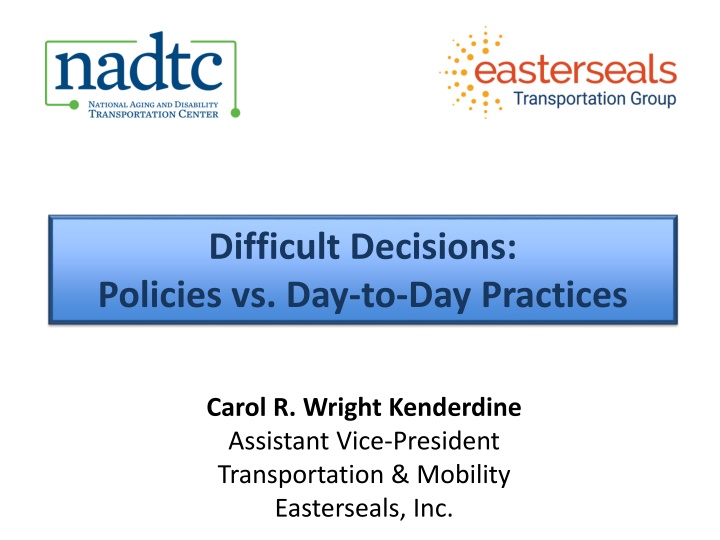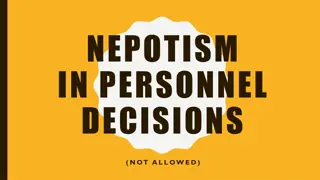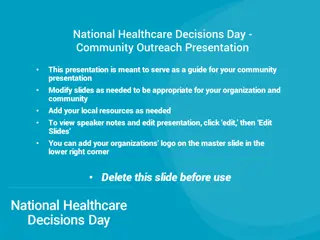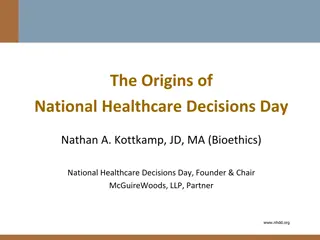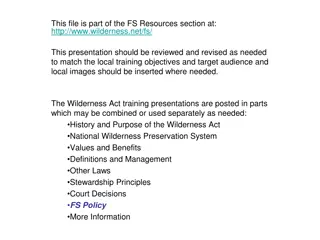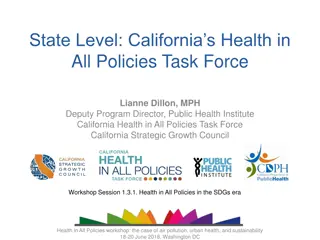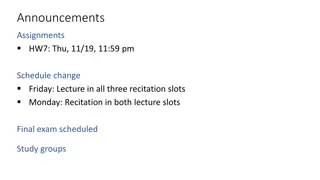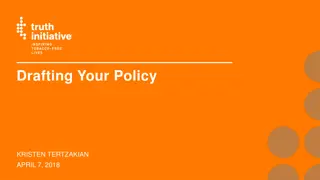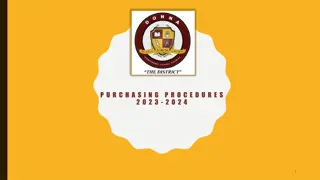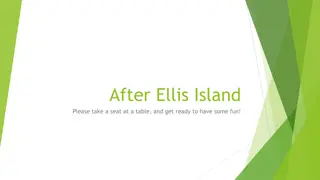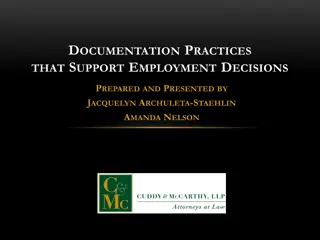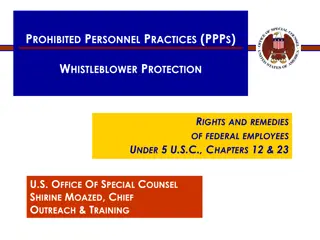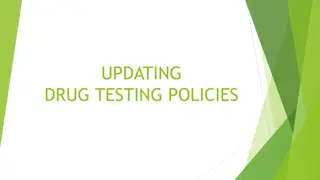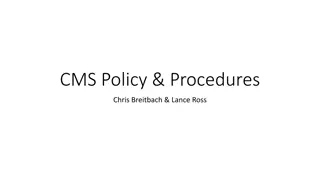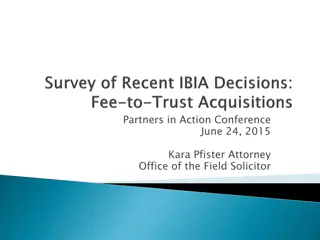Difficult Decisions: Policies vs. Day-to-Day Practices
Decisions on policies and day-to-day practices in transportation management are crucial for consistency, customer service, and legal protection. This involves understanding the difference between policies and procedures, effective communication of policies, the importance of consistency, setting rider policies, and improving communications within the organization.
Download Presentation

Please find below an Image/Link to download the presentation.
The content on the website is provided AS IS for your information and personal use only. It may not be sold, licensed, or shared on other websites without obtaining consent from the author.If you encounter any issues during the download, it is possible that the publisher has removed the file from their server.
You are allowed to download the files provided on this website for personal or commercial use, subject to the condition that they are used lawfully. All files are the property of their respective owners.
The content on the website is provided AS IS for your information and personal use only. It may not be sold, licensed, or shared on other websites without obtaining consent from the author.
E N D
Presentation Transcript
Difficult Decisions: Policies vs. Day-to-Day Practices Carol R. Wright Kenderdine Assistant Vice-President Transportation & Mobility Easterseals, Inc.
Overview Policies vs. Procedures Communicating Policies Why Consistency Matters Rider Policies Customer Service Making Decisions On the Road Reasonable Modification www.nadtc.org 2
Policies vs. Procedures Policy: A stated position on an issue that provides the written basis for rules regulating operations (passed by governing body/Board of Directors). Procedure: The way we implement our policy the how to instructions for putting the policy into day-to-day practice. 3
Policies and Procedures Are the backbone of your agency s operations Help determine appropriate actions & reactions Establish a consistent level of service & treatment of passengers Support your agency s vision & mission Are a reference for decision making Protect your staff, volunteers & riders 4
Policies: Important! Need to be formal Will be seen by others (internal & external) May need to support you in legal actions Depend on the understanding & interpretation of what is written Mistakes can be costly! 5
Communicating Policies Employee Handbook Bus Driver Manual/Handbook Rider s Guide All Staff Meetings Bus Driver Meetings Dispatcher Meetings Combined Driver/Dispatcher Meetings www.nadtc.org 6
Why Consistency Matters Equal treatment Staff members Customers For defense in case of lawsuits www.nadtc.org 7
Setting Rider Policies How are passenger policies communicated to your riders? Riders Guide Dispatcher Instructions Website Social Media Driver s Discretion www.nadtc.org 8
Improving Communications Are there ways you could improve these communications? www.nadtc.org 9
Rider Policies That Cause Conflict Refusal of Service Door-to-Door vs. Curb-to-Curb Number of Packages Assistance with Packages Fare Payment Strollers Food/Beverages Consumed Onboard www.nadtc.org 10
Rider Policies Poor Hygiene Intoxicated Passengers Foul Language Oversized Items Wait Time for Passenger Including waiting for passenger to pick up prescription; drop mail at Post Office; get cash at bank or make deposit at ATM; etc. www.nadtc.org 11
Policy Scenarios Scenario # 1 Sarah is an 85-year-old passenger with poor hygiene. She rides your bus to go to her doctor s appointments and to go grocery shopping. You have received a number of complaints from other passengers. Some drivers want her suspended from riding. What is your agency s policy? www.nadtc.org 12
Policy Scenarios Scenario # 2 Mary boards the bus. There are a number of passengers on the bus. She does not have a bus ticket or the fare to pay for her ride. She is a regular passenger. She has mild dementia. This has happened before. How should the driver handle the situation? What is your agency s policy? www.nadtc.org 13
Policy Scenarios Scenario #3 A passenger, John, gets on the bus and is very agitated. The passenger does not have money to pay the fare. The driver is not aware of the cause of the situation, but she is reasonably sure that pressing John for the fare or trying to force the customer off of the bus will only cause further disruption or escalate the situation. How should the driver handle the situation? What options does the driver have? What is your agency s policy? www.nadtc.org 14
Policy Scenarios Scenario #4 You have a curb-to-curb policy for your demand- response transit system. You have a passenger in a wheelchair who has requested door-through-door assistance as part of an ADA reasonable modification in order for her to use your transit service. A full-time driver, Joe, refuses to honor her request. The passenger states that Betty, another full-time driver provides this service. How do you resolve this conflict? What is your agency s policy? www.nadtc.org 15
Policy Scenarios Scenario #5 You have a passenger who frequently rides your bus. Sometimes she has her husband along as her personal care attendant who then rides free. Sometimes she rides alone. Your drivers are frustrated because they feel she is gaming the system. What do you need to do to resolve the situation? What is your agency s policy? www.nadtc.org 16
Review and Revise Policies Recognize indications that it is time for policy review or revision: More instances of policy violations Service has changed making policy irrelevant Increase in complaints from staff and/or passengers Review policies periodically (annually for ongoing effectiveness) www.nadtc.org 17
External Feedback It is not only how the agency sees its policies, but how the customers react to those policies. Monitor customer (& employee) feedback for patterns. www.nadtc.org 18
Policy WorkNever Done! www.nadtc.org 19
Customer Service We got rid of our customer service department. We got tired of people calling it all the time. www.nadtc.org 20
Customer Service Rules You can t teach a service culture you have to: live it. experience it. share it. show it. www.nadtc.org 21
Customer Service Less is almost always MORE! Nordstrom s Department Store s employee handbook reflects their emphasis on exceptional customer service with a total of 75 words. Welcome to Nordstrom. We re glad you are with our company. Our number one goal is to provide outstanding customer service. Set both your personal and professional goals high. We have great confidence in your ability to achieve them. Please feel free to ask your Department Manager, Store Manager or Human Resource office any questions at any time. www.nadtc.org 22
Customer Service Hire the right people and treat them right. Southwest Airlines Vice President of People is often asked the question, How do you get your employees to be so nice? The answer is always the same: When hiring someone, start with the premise that attitudes matter most. We hire NICE people! www.nadtc.org 23
Customer Service Engage your employees It starts with a compelling VISION one that focuses on your mission to serve. Every employee must be able to see how they fit into the big picture. How does their role contribute to the mission and the vision of the agency? www.nadtc.org 24
Customer Service How do you define your vision? James River Transit: MAKING A DIFFERENCE Too often company mission and/or vision statements are agonized over and then forgotten in a binder on a shelf. Every employee in the company can figure out how they can make a difference. www.nadtc.org 25
Customer Service Rule #4 First impressions last Even if you cannot immediately help someone, at least smile or nod to create a positive first impression. Greet your customer. Look like you are happy to see your passengers! www.nadtc.org 26
An Inside Job Determine if a passenger s first experience will be favorable or negative. When you get back to work, pretend you are a new customer. From the first time you call for a ride To the time you stand on the sidewalk as you wait to be picked up From stepping up into the bus or being taken up on the lift for the first time www.nadtc.org 27
An Inside Job From paying your fare To finding your seat (or having your wheelchair secured) From the first drop off To waiting for your pick- up to return home www.nadtc.org 28
First Impressions What are your first impressions? Do you know where to wait for the bus? What do you see?...hear?...smell?...feel? Is it easy to know how much to pay?...how to pay? Is it easy to know where to sit? Do you need to wear a seat belt? Do you feel comfortable asking questions? Is there adequate signage to answer questions? What do the signs say? www.nadtc.org 29
First Impressions If you were to call (please do!), would the person who answers the phone be easy to understand?...be friendly?...be able to speak another language? Would you have all the information you need before hanging up the phone? If you seem confused, will things be explained in a way that make it easier for you to understand?...does the person seem frustrated with you? www.nadtc.org 30
Repeat Performance! Rule #5 Reinforce. Reinforce.. Reinforce When you have a message you want to deliver to your customers, understand it won t happen on its own. You need to have a plan in place to make it happen and everyone needs to be onboard and agree to do it the same way. www.nadtc.org 31
Reinforce This may sound simple and like common sense. To do it right, it is anything but simple. It takes everyone being on the same page and being consistent. Everyone needs to be following the same policies and procedures. www.nadtc.org 32
Its the Little Things It s the little things that make the big things possible. Only close attention to the fine details of any operation makes the operation first class. J.W. Marriott www.nadtc.org 33
The Happiest Place on Earth Do what you do so well that they will want to come back again and bring their friends! Walt Disney www.nadtc.org 34
A Crash Course on Customer Service I apologize for our mistake. I m not sure but I will find out. Please. Thank you. I appreciate How is it best for me to assist you? I can take care of that for you. Have a good rest of your day. www.nadtc.org 35
Ask Yourself.? If customer service were a competitive event, where would you be in the rankings? www.nadtc.org 36
Transit Acronyms.HUGS! Have you H.U.G.G.E.D. a customer lately? Helped your customer beyond normal expectations? Understood the nature of the customer s needs? Gathered critical information by exploring the customer s situation? Given the customer a chance to talk while you listen? Empathized with the customer s position if there was a problem or unique circumstance? Developed a trusting relationship so your customer wants to return? www.nadtc.org 37
Viewing from the Outside In: Observe What do people who ride the bus worry about? How can you help alleviate their concerns? What don t they know about riding the bus? What do they need to know? What can we improve to make it better for all? Do the rules change driver to driver? www.nadtc.org 38
(Your transit agency) Believes in HUGGS Motto: Help Us Give (Great!) Service! www.nadtc.org 39
Customer Service vs. Policies & Procedures What does customer service have to do with Policies and Procedures? EVERYTHING! You are responsible for knowing the Policies and implementing them consistently across the entire agency. What one does for the customer everyone does because everyone follows the same procedures! www.nadtc.org 40
Areas Where Conflicts Tend to Occur The number one area where policies and procedures tend to collide, and drivers tend to disagree on the proper way to respond is in the area of: ADA REASONABLE MODIFICATION www.nadtc.org 41
Reasonable Modification Transit systems must modify their policies to accommodate the needs of people with disabilities unless the modified policies would result in: an undue burden or a fundamental alteration of the transit program, service or activity a direct threat to the health or safety of others without the requested modification, the individual with a disability is still able to fully use the entity s services, programs or activities for their intended purpose
Additional Requirements Information about the reasonable modification process and how to use it must be available to the public. The request process must be accessible. The process must provide for situations in which making an advanced request is not feasible Allowing bus drivers to make a determination Being able to contact supervisors for assistance and an on-the-spot decision Customers do not have to use the words reasonable modification when making their request.
Do I Have to Do THAT????? www.nadtc.org 44
ADA Reasonable Modification This leads to drivers sometimes making different decisions depending on the driver. Some drivers think they are adhering directly to the agency s policies. Some believe they are using their discretion to provide better customer service. Some believe they are doing what the ADA says they must. www.nadtc.org 45
Consistency & Education This is why everyone at the agency needs to: be educated about Reasonable Modification know what to do if they are unsure of how to handle a customer s special request have dispatchers and drivers relay the same messages to customers discuss concerns with management www.nadtc.org 46
Examples: Reasonable Modification www.nadtc.org 47
Question If the transit system provides curb-to-curb service, do they have to provide assistance to and from the door for a person with disabilities if needed? www.nadtc.org
Answer Yes. This would be considered a reasonable modification to the agency policy (unless doing so is a risk to safety of equipment and passengers). Agency must be able to satisfactorily establish the risk is great enough that they could not offer the assistance. The driver is never responsible for door-through-door service, unless this is a specific service offered by the agency.
Question The transit agency s policy is that all passengers going to the mall be picked up and dropped off at the mall s main entrance. Should the agency consider a modification to this policy for a passenger with a disability if the person needs the modification in order to take the service?
